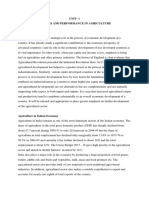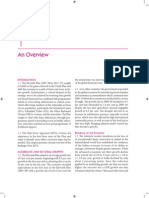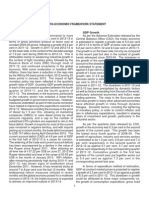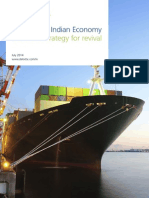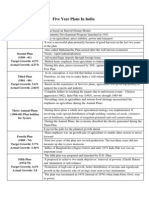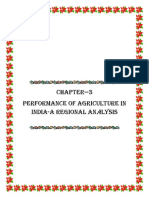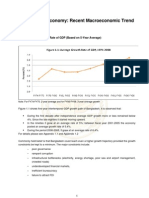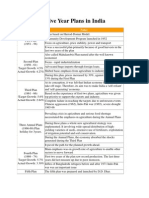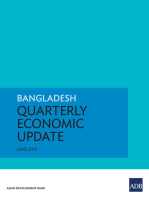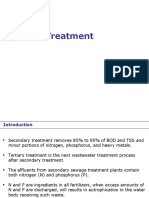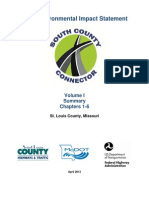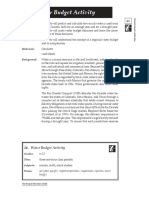Eleventh Five Year Plan A Review
Eleventh Five Year Plan A Review
Uploaded by
aabha06021984Copyright:
Available Formats
Eleventh Five Year Plan A Review
Eleventh Five Year Plan A Review
Uploaded by
aabha06021984Original Title
Copyright
Available Formats
Share this document
Did you find this document useful?
Is this content inappropriate?
Copyright:
Available Formats
Eleventh Five Year Plan A Review
Eleventh Five Year Plan A Review
Uploaded by
aabha06021984Copyright:
Available Formats
ELEVENTH FIVE YEAR
PLAN - A REVIEW
10
Chapter
Review of the Eleventh Five Year Plan
(2007-2012)
The socio-economic developments in Andhra Pradesh
have in tune with the national trends delineated a
distinct dynamic and expansionist phase since 2004-05
in all sectors of the State economy. The Eleventh Five
Year Plan commenced on a very optimistic note with
the 1
st
year (2007-08) of the plan period recording a
phenomenal economic growth in excess of 12%. It was
also encouraged by the strong economic resurrection
evident from a remarkable transition to a high growth
path during the 10
th
Five Year Plan. However, the sailing
was not entirely comfortable thereafter as the state
witnessed a relative slowdown for two years continuously
during 2008-09 and 2009-10 due to adverse seasonal
conditions, unprecedented foods and other natural
calamities coupled with volatile global conditions.
After the recovery in the penultimate year (2010-11) of
the 11
th
Plan, Andhra Pradesh much like the All-India
trends, managed to maintain the growth momentum
ensuring that the overall growth rate for the 11
th
Plan
remain above the coveted 8% mark coinciding with the
10
th
Plan growth performance. Inclusiveness, which
has eluded the masses for decades, however remained
as a core agenda for the upcoming fve year plan. A
comprehensive picture of the economic growth and
plan performance during the 11
th
Five Year Plan along
with the performance of various Flagship programmes
are presented below.
Overall Growth Performance
Amidst wide expectations, the state economy, as
measured by growth in the real Gross State Domestic
Product (GSDP), grew at 8.18% during the 11
th
Five
Year Plan period (2007-12) which is marginally higher
than the All Indias GDP growth of 8.03% for the same
period. The performance of the state economy during
the last three Five year plan periods has been better than
the national average, albeit marginally. In spite of the fact
that there is some shortfall in the overall achievement
during the 11
th
Plan period, compared to the growth
target, none the less the growth achievement can be
considered noteworthy.
The growth pattern reveals that the achievement during
the 11
th
Plan can essentially be attributed to a signifcant
contribution in the frst year (12.02% in 2007-08) and the
penultimate year (9.96% in 2010-11) of the Plan period.
The year 2009-10 was disappointing as the growth
rate slipped down to 4.53%, the lowest in recent past.
The low growth was essentially due to a rather dismal
performance of the agriculture sector, whose growth rate
was just 0.2%. The growth rate of 7.82% in the terminal
year (2011-12) of the 11
th
Plan, however shows some
promise for sustained growth. The agriculture sector,
for the third time in the 11
th
Plan period, put up a poor
show during the terminal year by registering a growth
rate less than 1%. The Services sector with a fabulous
growth rate of 10.53% supported by the Industry sector
with a modest growth rate of 7.71% however gave some
solace.
Agriculture Sector
Analysis of broad sectoral growth rates for the 11
th
Plan period reveal mixed trends. As outlined above, the
Agriculture sector, which on the average accounts for
about 12% of the overall GSDP, managed a relatively
better performance during the 11
th
Plan period (average
growth of 5.28%) as compared to the 10
th
Plan (3.98%).
Interestingly, agriculture sector, which continues to
provide employment and livelihood to a large population
despite its shrinking share in the economy, remained
a growth pointer. This is evident from the fact that
during the 11
th
Plan period, whenever the agriculture
sector fared well, the economy as a whole put up an
encouraging performance.
The foodgrain production which accounts for nearly
35% of the agricultural GSDP, continues to remain
vulnerable to the vagaries of monsoon. The foodgrain
production in the State during the 11
th
Plan period has
mostly been progressive. After touching a record level
226
of 204 lakh tonnes in 2008-09, the foodgrain production
slipped to 156 lakh tonnes during 2009-10 due to adverse
seasonal conditions and bounced back thereafter to
203 lakh tonnes in 2010-11. However, the foodgrains
production has come down to 184 lakh tonnes during
2011-12 due to defcient rainfall and consequent drought
conditions that prevailed across the state.
The impact of slowdown coupled with adverse seasonal
conditions in the State is evident in almost all sub-sectors
within Agriculture sector. The Livestock sub-sector
of late has emerged as an important alternate source
of income to a large number of small and marginal
farmers, particularly in drought prone areas. The State
accounts for more than 10% of the countrys livestock
and ranks 1st in Egg and Meat production and 2nd in
milk production. The Government has formulated a
State Milk Mission envisaging a huge outlay benefting
25 lakh persons spreading over a period of next fve
years to enhance production in the State. The Livestock
sub-sector which on average contributes more than 26%
of the Agri-GSDP and 5.4% of the overall GSDP grew
at 7.1% during the 11th Plan period.
Fisheries is yet another promising sub sector in the
State. The State ranks second in the country in fsh
production. The Fisheries sub-sector which on average
contributes 12.1% of the Agri-GSDP and 2.6% of the
overall GSDP grew at over 10% during the 11th Plan
period.
Forestry in the State has been consistently growing
around 2% during the 11
th
Plan period. Several Forestry
programmes to protect and develop existing forest area
and bring back tree cover to desired levels are being
implemented. More than 5 lakh hectares of degraded
forest is being protected, developed and managed by
Vana Samrakshna Samithis in the State. The Forestry &
Logging sub-sector which on average contributes 5.57%
of the Agri-GSDP and 1.2% of the overall GSDP has
grown at 1.9% during the 11
th
Plan period.
Overall during the 11
th
Plan period, the Agriculture
sector on average contributed 21.27% of the GSDP and
grew at 5.28%.
Industry Sector
During the 11
th
Plan period, the Industry sector on
average contributed over 25% of the GSDP and grew
at 7.26%, which however was lower than the 10
th
Plan
achievement. Power shortage has led to much of the
slowdown in the industry sector. Power and other
physical infrastructure are required to grow faster to
boost the industrial growth momentum.
Within the Industry sector, Electricity, Gas and Water
Supply sub sector grew with an impressive growth rate
of 10.07% and Construction subsector with a growth
rate of 8.24% maintained a steady and sustained growth.
Mining & Quarrying subsector, showing a volatile trend,
grew at 3.12%. However, after witnessing a slump during
2008-09, this subsector has recovered considerably in
subsequent years of the 11
th
Plan period.
The manufacturing sub-sector (registered& un-
registered), which on average accounts for more than
48% of the Industrial GSDP and over 12% of the
GSDP, grew at 7.63% during the 11
th
Plan period.
The Registered and un-registered components of the
manufacturing sector accounted for about 36% and 12%
of the Industrial GSDP respectively. The manufacturing
sector has to grow at a higher pace if the Industry sector
is to propel overall growth momentum and employment.
Services Sector
Services sector continues to garner a lions share (over
53%) in the GSDP and the consistently high growth rates
in this sector has resulted in a growth of 9.81% during
the 11
th
Plan period. Sub-sectors of Communications,
Banking & Insurance, Real estate & Business services
and Transport (other than Railways) & Storage have
shown encouraging trends under the Services sector.
Per Capita Income
Noteworthy increases in Per Capita Income in the recent
past broadly indicate improvement in livelihoods of
people. The Per Capita Income of the state at current
prices has more than doubled in a span of fve years-
from Rs. 33,135 during 2006-07 to Rs. 68,970 in 2011-
12, the terminal year of the 11
th
Plan period. In fact,
the growth in Per Capita Income of the State is more
rapid compared to All-India fgures and the state has
maintained the dominance for the entire 11
th
Plan period.
Effective implementation of several poverty-alleviating
and employment generating programmes of the State
and those sponsored by the Centre, aided by a better
delivery mechanism and safety nets in place, have helped
people maintain relatively better standards.
Annual Plans A Recap of Performance
Against the total outlay (the sum of the outlays
227
approved by the Planning Commission for the annual
plans of the Eleventh Plan Period - 2007-08 to 2011-12)
of Rs.1,87,796.75 crore, an amount of Rs.1,58,020.86
crore has been spent accounting for 84.14% of the total
outlay.
During the 11
th
Plan period (2007-08 to 2011-12),
Economic Services accounted for larger part of the total
outlay (about 64%), followed by Social Services (over
35%) and General Services less than 1%. Almost similar
shares of expenditure have been recorded by each of
these broad sectors (as a percentage to total expenditure).
Irrigation sector with an outlay share of 39.8%, Housing
with 8.9% share and Rural Development with 8.1%
are the major stakeholders in the total outlay. Other
prominent sectors include: Urban Development, Welfare
and Transport sectors.
A perusal of the broad sectoral classifcation reveals
that, an outlay of Rs.120068.51 Crores (63.94% of the
total outlay) was provided against which Rs.100029.56
Crores (83.31% to sectoral outlay) has been spent
under Economic Services in the Eleventh Five Year
Plan. The outlay for Social services was Rs.66659.13
Crores (35.50% of the total outlay) and expenditure Rs.
57229.93 crores (85.85% of sectoral outlay) and under
General services an amount of Rs.1069.11 crores was
provided as outlay, which is less than 1% of the total
outlay, and an expenditure of Rs.761.37 crores was
incurred.
Sizable investments have been made under economic
services, in the irrigation and food control sector to
achieve targeted agricultural growth by creating more
irrigation potential. To this effect, the Government
during the year 2004 has taken up plans for fully utilizing
available yields of Godavari and other rivers and initiated
the Jalayagnam with an aim to complete ongoing and
other new projects to provide immediate irrigation to
water-starving segments on top priority. In tune with
this broad strategy, the State Government allocated an
outlay of about 40% i.e. Rs.74732.52 crores during the
Eleventh Five year plan and incurred an expenditure of
Rs.54023.86 crores which works out to 72.29% of its
total outlay.
Ensuring food security and providing employment to the
labour force has been the essential premise of the socio-
economic development policies of the government.
Keeping this in view, due priority was accorded to
Agriculture and Allied sectors in the Eleventh Five
plan period wherein Rs.10401.86 crore expenditure was
incurred exceeding the outlay of Rs.7958.37 crore.
Appropriate planning, scientifc approach and effcient
management systems have been put in place under Rural
Development to increase productivity of degraded
lands and create employment opportunities for the
poor. Development of degraded lands was regarded as
an important input required for eradication of poverty..
Watersheds Development Programme, Comprehensive
Land Development Programme and Wage Employment
Programmes (MGNREGS-AP) are being implemented
in the State are some such intiatives. To this effect, greater
emphasis was accorded in the Eleventh Five Year Plan
period to these activities. Under Rural Development,
Rs.16330.24 crores was spent (106.94% to its outlay and
10.33% of the total expenditure) against an outlay of
Rs.15269.84 Crores (8.13% of total outlay).
Transport Sector, with an outlay of Rs.10332.23 Crores
accounted for a share of 5.50% in the total outlay during
the Eleventh Five Year Plan, and the expenditure was
Rs.9983.65 Crores(6.32% of the total expenditure).
Under General Economic Services, the expenditure for
Eleventh Five Year Plan period was Rs.4361.78 Crores,
which amounts to 75.13% of its outlay of Rs. 5805.85
Crores.
The state has committed itself to focus on increasing
public spending on social sector, especially on Housing,
Urban development and welfare of SCs, STs, minorities
etc besides setting up targets under priority sectors like
irrigation, agriculture and rural development and aiming
to ensure faster social development through inclusive
pattern of growth.
The Government has emphasised the Housing Sector
and allocated an outlay of Rs.16,688.36 crores during
the 11
th
Plan period for providing houses. Rs.11696.54
crores expenditure was incurred which is 70.09% of
the housing sector outlay.
The Mid-Day Meal Programme is being implemented in
the state to children of 1st to 5
th
class in Government/
Local Bodies/Aided schools to increase nutrition of
children. The programme was later further extended
up to 8
th
class to improve retention in schools and to
achieve total literacy in the state. The Government
continued its focus on school education and initiated
several steps including expansion of mid-meal scheme
and providing books free of cost to students up to 10
th
class in Government schools to increase enrolment
and reduce drop outs. To this effect, Rs.6308.80 crore
228
was spent which works out to 78.92% of the General
education sector outlay against an outlay of Rs.7994.19
crore allotted during the Eleventh Plan period under
General education.
The Government observed that the share of public
expenditure on Health compared to private investment
in health is low. To correct this imbalance in the Eleventh
plan, the Government initiated various programmes to
reduce Infant Mortality Rate, Maternal Mortality Ratio,
Total Fertility Rate and to increase institutional deliveries
and Children Immunization Rate. The Government took
up the initiative Rajiv Aarogya Sree Community Health
Insurance under public private partnership to improve
access of BPL families to quality medical treatment
of diseases involving hospitalization and surgery. The
Government allotted an outlay of Rs.6752.68 Crores for
Medical and Public Health and incurred an expenditure
of Rs.6288.27 Crores (93.12% to its outlay) to meet this
objective in the Eleventh Five year Plan.
The detailed outlay and expenditure statements are
outlined in Annexure 10.1.
Performance of Flagship Programmes
With a view to impart greater momentum to the
efforts being made in various sectors, the Government
of India has launched fagship programmes under
economic infrastructure sector and social sectors. In the
recent past, there has been a growing concern for the
implementation of fagship programmes.
The Chaturvedi Committee on restructuring of the
Centrally Sponsored Schemes(CSS) suggested fexibility
in the design of the CSS to be given to States to meet
their special local needs. The committee suggested that
20% of the budget allocation in all the CSS (10% in
Flagship schemes) to be called fexi funds should be
earmarked in each scheme for this purpose.
Effective implementation of fagship programmes of
the Government of India is going to be cornerstone of
development in the coming years, especially during the
12
th
Five Year Plan.
The fagship programmes being implemented by the
State are:
Rashtriya Krishi Vikas Yojana (RKVY),
National Horticulture Mission (NHM),
Mahatma Gandhi National Rural Employment
Guarantee Scheme (MGNREGS),
Accelerated Irrigation Beneft Programme (AIBP),
Rajiv Gandhi Grameena Vidyutikaran Yojana
(RGGVY)/ Re-structured Accelerated Power
Development and Reforms Programme (R-APDRP),
National Rural Drinking Watersupply Programme
(NRDWP),
Total Sanitation Campaign (TSC)/ Nirmal Bharat
Abhiyan(NBA),
Indira Awaas Yojana (IAY),
Jawaharlal Nehru National Urban Renewal Mission
(JNNURM),
Pradhan Mantri Gram Sadak Yojana (PMGSY),
Sarva Shiksha Abhiyan (SSA),
Mid Day Meal Scheme (MDM),
National Rural Health Mission (NRHM)
Integrated Child Development Services (ICDS).
National Social Assistance Programme(NSAP)
National Rural Livelihood Mission (NRLM)
Backward Regions Grant Fund (BRGF)
The performance of various fagship programmes
during the 11
th
Five Year Plan period and for the year
2012-13 is briefed hereunder.
Financial Performance of Flagship programmes
(Rs. Crore)
Sl.
No
Year
Releases
Expenditure
Centre State Total
1 2007-08 6307.65 3727.57 10035.22 9224.75
2 2008-09 8707.00 5328.02 14035.02 11890.86
3 2009-10 11053.71 7099.63 18153.34 15788.53
4 2010-11 14038.50 5812.08 19850.58 15942.73
5 2011-12 9567.30 8038.00 17605.30 17480.82
Total
(2007-08
to 2011-12)
49674.16 30005.30 79679.46 70327.69
2012-13 7626.39 4662.97 12289.36 11855.73
Rashtriya Krishi Vikasa Yojana
Government of India (GOI) have launched Rashtriya
Krishi Vikasa Yojana (RKVY) as an Additional
Central Assistance scheme (100%) in the year 2007-
08 to incentivize states for increasing investments in
Agriculture and allied Sectors to achieve a annual growth
in excess of 4%.
229
Objectives
To ensure that the local needs/ crops/priorities are
better refected in the agricultural plans of the states.
To achieve the goal of reducing the yield gaps in
important crops through focused interventions.
To maximize returns to the farmers.
To bring quantifable changes in production and
productivity of various components by addressing in
a holistic manner.
During 11th Plan period, an amount of Rs. 1861.74
crore has been spent under the scheme. An amount of
Rs. 344.61 crore has been spent for the year 2012-13(up
to December 2012)
National Horticulture Mission
The State Horticulture Mission(SHM) in Andhra
Pradesh was launched on 3
rd
November, 2005, under
National Horticulture Mission with the following main
objectives:
To provide holistic growth of the horticulture
sector in cluster approach which include research,
technology promotion, extension, post harvest
management, processing and marketing.
To enhance horticulture production, improve nutritional
security and income support to farm households.
To establish convergence and synergy among multiple
on-going and planned programmes for horticulture
development.
To create opportunities for employment generation for
skilled and unskilled persons, especially unemployed
youth.
The focus crops under SHM are: 1.Mango 2. Sweet
Orange 3. Sapota 4. Pomegranate 5.Banana 6.Papaya
and 7.Cashew 8. Flowers 9. Spices
For carrying out the said activities, an amount of Rs.
607.73 crores during 11
th
Five Year Plan. An amount
of Rs. 88.77 crores has been spent for the year 2012-13
(up to December 2012) has been spent.
Mahatma Gandhi National Rural
Employment Guarantee Scheme
Mahatma Gandhi National Rural Employment
Guarantee Act gives legal guarantee of providing at
least 100 days of wage employment to rural households
whose adult members are willing to do unskilled manual
labour.
The programme is covered in all the rural areas in 22
Districts in three phases.
An amount of Rs. 18981.45 crores has been spent
during 11
th
Plan i.e 2007-08 to 2011-12. An amount of
Rs.4088.68 crore has been spent for the year 2012-13
(up to December 2012). The Government has enhanced
the number of work days per year 150 and the wage rate
Rs. 137 per day.
This programme has so far covered 55 Lakh households
for the year 2012-13 through issuing 5.35 lakh no.
of job cards in 22 districts of Andhra Pradesh. The
implementation of the scheme in Andhra Pradesh
has been improving over time. Implementation of the
programme in the State has received much acclaim by
various apex level bodies and monitoring agencies.
Accelerated Irrigation Beneft Programme
Government of India have initiated assistance under
Accelerated Irrigation Beneft Programme (AIBP) to
complete the ongoing major and medium irrigation
projects taken up with Central Water Commission and
Planning Commission Clearances, since 199697 to
create Irrigation Potential at optimum cost, based on the
guidelines issued from time to time.
Projects Sanctioned
33 projects (7 Major and 16 Medium Irrigation
Projects) have been included under A.I.B.P. since
1996-97.
11 Projects (i.e., 5 Major and 6 Medium Irrigation)
included prior to 2004 2005.
22 Projects (12 Major and 10 Medium Irrigation)
included after 2005 -2006.
A total amount of Rs. 11785.03 crores has been spent
during 11
th
Five Year Plan under various AIBP projects
in the state. An amount of Rs. 664.20 crore has been
spent for the year 2012-13(up to December 2012).
Rajiv Gandhi Grameena Vidyutikaran Yojana
The Government of India has introduced Rajiv Gandhi
Grameena Vidyutikaran Yojana (RGGVY) programme
in the year 2005 with the twin objectives of electrifcation
230
of villages and to provide access to electricity to BPL
households in the country.
An amount of Rs. 886.31 crores was incurred under the
programme during 11
th
plan 2007-08 to 2011-12.
National Rural Drinking Water Programme
National Rural Drinking Water Programme (NRDWP)
was launched by GOI in 2009-10 in place of Accelerated
Rural Water Supply Programme (ARWSP). The
programme intends to provide safe and adequate
drinking water facilities to quality affected habitations,
not covered habitations and partially covered habitations
in rural areas. The program provides special thrust on
sustainability of drinking water sources and funds
recharge structures with 100% grant.
An amount of Rs. 4119.31 crores was spent during 11th
Plan. An amount of Rs. 371.98 crore has been spent for
the year 2012-13(up to December 2012).
Under the National Rural Drinking Water supply
Programme, drinking water is provided to 72,387
habitations. 44,720 (61.8%) habitations are fully covered
with supply of 40 Litres Per Capita Per Day (LPCD) and
more safe drinking water, a norm for fully covered status
and 27,276(37.7%) habitations partially covered and 391
are quality affected.
Total Sanitation Campaign
Total Sanitation Campaign (TSC) has been launched by
Government of India to ensure sanitation facilities in
rural areas with broader goal to eradicate the practice
of open defecation by bringing about behavior change.
This programme is being implemented with the district
as a unit.
The TSC is now renamed as Nirmal Bharat Abhiyan
(NBA) with modifed guidelines and objectives to
accelerate further the sanitation coverage in the rural
areas so as to comprehensively cover the rural community
with renewed strategies under the programme. The
guidelines of NBA and the provisions hereunder are
applicable with effect from 01.04.2012. Nirmal Bharat
Abhiyan (NBA) envisages covering the entire community
for saturated outcomes with a view to create Nirmal
Gram Panchayats (NGPs) with following priorities:
Provision of Individual Household Latrine (IHHL)
of both Below Poverty Line (BPL) and Identifed
Above Poverty Line (APL) households within a
Gram Panchayat (GP)
Gram Panchayats where all habitations have access to
water to be takenup. Priority may be given to Gram
Panchayats having functional piped water supply.
Provision of sanitation facilities in Government
Schools and Anganwadis in Government buildings
within these GPs
Solid and Liquid Waste Management (SLWM) for
proposed and existing Nirmal Grams
Extensive capacity building of the stake holders like
Panchayati Raj Institutions (PRIs), Village Water
and Sanitation Committees (VWSCs) and feld
functionaries for sustainable sanitation.
Appropriate convergence with MGNREGS unskilled
man-days and skilled man-days.
The main objectives of the NBA are as under:
a) Bring about an improvement in the general quality of
life in the rural areas.
b) Accelerate sanitation coverage in rural areas to
achieve the vision of Nirmal Bharat by 2022 with
all gram Panchayats in the country attaining Nirmal
status.
c) Motivate communities and Panchayat Raj Institutions
promoting sustainable sanitation facilities through
awareness creation and health education.
d) To cover the remaining schools not covered under
Sarva Shikha Abhiyan (SSA) and Anganwadi Centres
in the rural areas with proper sanitation facilities and
undertake proactive promotion of hygiene education
and sanitary habits among students.
e) Encourage cost effective and appropriate technologies
for ecologically safe and sustainable sanitation.
f) Develop community managed environmental
sanitation systems focusing on solid & liquid waste
management for overall cleanliness in the rural areas.
An amount of Rs. 403.19 crores was spent during 11
th
Plan and an amount of Rs. 60.36 crores has been spent
for the year 2012-13(up to December 2012).
Indira Awaas Yojana
The scheme intends to provide Houses to BPL families
(SC/ST/Minorities/others) living in rural areas.
Under the IAY programme, in all, a total amount of
231
Rs. 4996.11 crores has been spent during 11
th
Five Year
Plan. An amount of Rs.983.53 crores has been spent for
the year 2012-13(upto December, 2012). The amount
includes the state contribution and the Central allocation.
Under the IAY scheme, 1,62,968 houses to SC/STs and
39217 houses to Minorities and 68214 houses to others
have been sanctioned under IAY programme for the
year 2012-13.
Jawaharlal Nehru National Urban Renewal
Mission
The Government of India has initiated JnNURM in
order to cope with massive problems that have emerged
as a result of rapid urban growth, reforms driven, fast
track, planned development of identifed cities on a
mission mode with focus on improve effciency in urban
infrastructure/services delivery mechanism, community
participation and accountability of Urban Local Bodies/
Parastatals towards citizens. The main components of the
programme are: Urban Infrastructure and Governance
(UIG), Basic Services for the Poor (BSUP), Urban
Infrastructure and Development Scheme for Small and
Medium Towns (UIDSSMT) and Integrated Housing
and Slum Development Programme: (IHSDP)
Under JnNURM, an amount of Rs. 5937.21 crores has
been spent during 11
th
Five Year Plan and an amount
of Rs. 505.75 crore has been spent for the year 2012-13
(up to December 2012).
Pradhan Mantri Gram Sadak Yojana
Pradhana Mantri Gram Sadak Yojana (PMGSY) was
launched with an aim to provide all-weather access to
unconnected habitations. It is 100% centrally sponsored
scheme. All weather connectivity is to be provided to
all the habitations with population of 500 and above
(250-500 in case of hilly and tribal areas) under this
programme. The programme was commenced in the
year 2000-01.
Under this programme, a total amount of Rs.2562.18
crores has been spent during 11
th
Five Year Plan. An
amount of Rs. 173.13 crores has been spent for the year
2012-13(up to December 2012).
Sarva Shiksha Abhiyan
Sarva Shiksha Abhiyan has been introduced during
2001-02, with an aim to provide useful and relevant
elementary education for all children in the 6 to 14 age
group. SSA intends to bridge social, regional and gender
gaps, with the active participation of the community in
the management of schools. The funding pattern for the
year 2012-13 is 65:35, between GOI and GOAP.
Under the SSA programme, an amount of Rs. 6922.83
crores was spent during the 11
th
Five Year Plan(2007-08
to 2011-12) and an amount of Rs. 1675.90 crores has
been spent for the year 2012-13(up to December 2012).
Mid Day Meal Scheme
The objective of the scheme is to improve the
nutritional status of children. The scheme also envisages
encouraging poor children, belonging to disadvantaged
sections to attend school more regularly and to provide
nutritional support to children.
Coverage
61,415 Primary Schools including Madarsas/ Maqtabs/
AIE/EGS Centres/NCLP Schools at primary stage,
9,216 Upper Primary Schools and 10,292 High Schools
are covered with enrollment of 75.54 lakh children.
Under the Mid-Day Meal programme, an amount of
Rs. 2320.69 crores, has been spent during 11
th
Five Year
Plan period. an amount of Rs. 448.88 crore has been
spent for the year 2012-13(up to December 2012).The
amounts include the state contribution and the Central
allocation.
National Rural Health Mission
The Rural Health scheme was launched by the GoI with
focus on:
Reduction in Infant Mortality Rate (IMR) and
Maternal Mortality Ratio (MMR)
Universal access to public health services such as
Womens health, child health, water, sanitation &
hygiene, immunization, and Nutrition.
Prevention and control of communicable and non-
communicable diseases, including locally endemic
diseases
Access to integrated comprehensive primary
healthcare
Population stabilization, gender and demographic
balance.
Revitalize local health traditions and mainstream
AYUSH
232
Promotion of healthy life styles
For implementation of various items subsumed
under NRHM, in all an amount of Rs. 3146.89 crores
during 11
th
plan 2007-08 to 2011-12. An amount of
Rs. 570.20 crores has been spent for the year 2012-13
(up to December 2012).
Integrated Child Development Services
The Integrated Child Development Services (ICDS) is
a centrally sponsored scheme and is the single largest
integrated programme of Child Development.
For undertaking various ICDS activities, an amount of
Rs. 4133.71 crores has been spent during 11
th
Five Year
Plan and an amount of Rs. 730.84 crore has been spent
for the year 2012-13(up to December 2012).
A total of no. 387 ICDS projects have been implemented
with 87,880 AWCs in the state.
With regard to physical achievements under
supplementary nutrition, in all 55.55 lakh persons have
been benefted under the programme during the year
2012-13 so far.
National Social Assistance Programme
The NSAP is a fagship programme of the Government
of India which aims to provide human security to the
poor and the destitute. The programme was launched
on 15 August 1995 as a wholly Centrally funded program
to give fnancial assistance to families with little or no
regular means of subsistence, living below the poverty
line. NSAP presently consists of three components,
namely, NOAPS, NFBS, -and Annapurna Scheme.
Under this programme, in all, a total amount of Rs.
1663.31 crores has been spent during 11
th
Five Year
Plan and an amount of Rs. 379.28 crores has been spent
for the year 2012-13(up to December 2012).
National Rural Livelihood Mission
NRLM was launched by Government of India in June
2011 replacing Swarnjayanti Gram Swarojgar Yojana
(SGSY). It is a centrally sponsored scheme funded by
the Government of India and the State Government
in the ratio of 75:25. The Mission aims at creating
effcient and effective institutional platforms of rural
poor enabling them increase household income through
sustainable livelihood enhancements and improved
access to fnancial services and is aided in part through
investment support by the World Bank.
NRLM constitutes a paradigm shift in the implementation
of poverty alleviation programmes in the country. NRLM
would provide a combination of fnancial resource and
technical assistance to states such that they could use the
comprehensive livelihoods approach encompassing four
inter-related tasks viz.,
mobilizing all rural, poor households into effective
self-help groups (SHGs) and their federations;
enhancing access of the rural poor to credit and
other fnancial, technical and marketing services;
building capacities and skills of the poor for gainful
and sustainable livelihoods;
Improving the delivery of social and economic
support services to the poor.
An amount of Rs.119.33 crore has been spent for the
year 2012-13 (up to December 2012).
Backward Regions Grant Fund
The scheme Backward Regions Grant Fund (BRGF)
formerly known as Rashtriya Sam Vikas Yojana (RSVY)
is being implemented to address the problems of low
agricultural productivity, Unemployment, and to fll the
critical gaps in physical and social infrastructure so as
to redress regional imbalances in development. The
Programme is being implemented in 13 districts. Out
of these 13 districts, Adilabad, Ananthapur, Warangal,
Chittoor, Kadapa, Ranga Reddy, Mahaboobnagar and
Vizianagaram are identifed under Backward Districts
Initiative and Karimnagar, Khammam, Medak,
Nalgonda and Nizamabad are identifed under Left
Wing Extremism.
The District Collector with the assistance of concerned
executive agencies in Panchayat Raj Department is
implementing the scheme. Various activities like
construction of anganwadi buildings, gram panchayat
buildings, health sub-centres, and additional class rooms,
roads & drainage, drinking water facilities, sanitation and
electricity are being taken up under this programme. An
amount of Rs.197.07 crore has been spent for the year
2012-13 (up to December 2012).
233
You might also like
- (Indian Economy - 2) UNIT - 1 POLICIES AND PERFORMANCE IN AGRICULTUREDocument31 pages(Indian Economy - 2) UNIT - 1 POLICIES AND PERFORMANCE IN AGRICULTUREAndroid Boy75% (8)
- Bulk Water SeparationDocument1 pageBulk Water SeparationSean MiddletonNo ratings yet
- DLL Earth Science Week 5Document5 pagesDLL Earth Science Week 5Jynepher Asok100% (1)
- Eleventh Five Year Plan - A ReviewDocument11 pagesEleventh Five Year Plan - A ReviewNarender ParaskerNo ratings yet
- 11th Plan AchievementsDocument7 pages11th Plan AchievementsAvi HafNo ratings yet
- Eleventh Five Year PlanDocument8 pagesEleventh Five Year PlanAhmad Hasim BalesriaNo ratings yet
- Econom Is Survey Eng 1011Document178 pagesEconom Is Survey Eng 1011Goldi NegiNo ratings yet
- 2011Document494 pages2011aman.4uNo ratings yet
- Agriculture Data 2013Document20 pagesAgriculture Data 2013VineetRanjanNo ratings yet
- Economic Survey 2011-12 PDFDocument286 pagesEconomic Survey 2011-12 PDFsantoshNo ratings yet
- Chap1 OverviewDocument20 pagesChap1 Overviewamolsam1No ratings yet
- Indian Agriculture Performance and ChallengesDocument20 pagesIndian Agriculture Performance and ChallengesAshis Kumar MohapatraNo ratings yet
- Economic Survey of Pakistan: Executive SummaryDocument12 pagesEconomic Survey of Pakistan: Executive SummaryBadr Bin BilalNo ratings yet
- Economic Survey AgricultureDocument19 pagesEconomic Survey AgricultureAnand SharmaNo ratings yet
- India FRBMDocument6 pagesIndia FRBMindianeconomistNo ratings yet
- Draft Approach To 12th Plan For Discussion PDFDocument171 pagesDraft Approach To 12th Plan For Discussion PDF45satishNo ratings yet
- UploadDocument4 pagesUploadSanyog MehtaNo ratings yet
- AP Economic Survey 2011-12Document233 pagesAP Economic Survey 2011-12VAMSIKRISHNAEEENo ratings yet
- 11th Five Year Plan of IndiaDocument3 pages11th Five Year Plan of IndiaReema KumariNo ratings yet
- Planning PPT Plan Holiday 4th Plan To Seventh PlanDocument24 pagesPlanning PPT Plan Holiday 4th Plan To Seventh Planchris castelaryNo ratings yet
- Pestle Analysis of Indian AgricultureDocument32 pagesPestle Analysis of Indian Agriculturesheikhtalha94% (33)
- Growth Crisis in Agriculture: Severity and Options at National and State LevelsDocument6 pagesGrowth Crisis in Agriculture: Severity and Options at National and State LevelsNidheesh JosephNo ratings yet
- GDP NewDocument4 pagesGDP NewNeelesh BhandariNo ratings yet
- 12th Plan IndiaDocument359 pages12th Plan IndiaNavneet KumarNo ratings yet
- Economic Survey Himachal Pradesh For 2013-2014Document164 pagesEconomic Survey Himachal Pradesh For 2013-2014royalmdudeNo ratings yet
- Group 2 - Agricultural Sector ReportDocument24 pagesGroup 2 - Agricultural Sector ReportNanak ChhabraNo ratings yet
- Knowledge Article 1 - State of Indian EconomyDocument8 pagesKnowledge Article 1 - State of Indian Economyanup_navandarNo ratings yet
- Macro-Economic Framework Statement: Overview of The EconomyDocument6 pagesMacro-Economic Framework Statement: Overview of The Economyknew1No ratings yet
- EconomicSurveyEng2015 16 A1bDocument158 pagesEconomicSurveyEng2015 16 A1bAvinash ThakurNo ratings yet
- State of EconomyDocument21 pagesState of EconomyHarsh KediaNo ratings yet
- India Economic ReformsDocument18 pagesIndia Economic ReformsMitesh GalaNo ratings yet
- 5 Year Plans of IndiaDocument3 pages5 Year Plans of IndiaJustin MooreNo ratings yet
- Article of Economic TimesDocument5 pagesArticle of Economic TimesHarin LydiaNo ratings yet
- Economic SurveyDocument161 pagesEconomic SurveyRahul Sharma100% (1)
- Agriculture and Food ManagementDocument21 pagesAgriculture and Food ManagementShweta AroraNo ratings yet
- Chapter-3 Performance of Agriculture in India-A Regional An LysisDocument35 pagesChapter-3 Performance of Agriculture in India-A Regional An LysisLokanath ChoudhuryNo ratings yet
- Bangladesh Economy: Recent Macroeconomic Trend: 1.0 Real SectorDocument7 pagesBangladesh Economy: Recent Macroeconomic Trend: 1.0 Real SectorRasel RahmanNo ratings yet
- Summary of 5 Yr PlansDocument4 pagesSummary of 5 Yr PlansShilpi PriyaNo ratings yet
- Apeconomicsurvey2009 10finalDocument206 pagesApeconomicsurvey2009 10finalKrishnarao PujariNo ratings yet
- GDP Growth Sustained: Total Expenditure Has Increased by Rs. 192669 Crore in 2016-17 (BE) From 2015-16 (RE)Document4 pagesGDP Growth Sustained: Total Expenditure Has Increased by Rs. 192669 Crore in 2016-17 (BE) From 2015-16 (RE)Aryan DeepNo ratings yet
- Moving Towards Normal GrowthDocument1 pageMoving Towards Normal Growthrohit vyasNo ratings yet
- Dangers To Indian EconomyDocument5 pagesDangers To Indian EconomySmriti KushwahaNo ratings yet
- Economic Survey 2012 India Is Not Shining May 2012Document6 pagesEconomic Survey 2012 India Is Not Shining May 2012jayant-212002No ratings yet
- Apeconomicsurvey2011 12Document330 pagesApeconomicsurvey2011 12Naga ChennamNo ratings yet
- Annual Plan 2012 13 v7Document409 pagesAnnual Plan 2012 13 v7anilkc9No ratings yet
- Rainfed Agriculture in JharkhandDocument52 pagesRainfed Agriculture in Jharkhand9814189277No ratings yet
- EconSurveyEng2018 19Document170 pagesEconSurveyEng2018 19rishu_thakurNo ratings yet
- GDP Growth, Q1FY11: Pace of Growth Accelerates To 8.8%: ContactsDocument6 pagesGDP Growth, Q1FY11: Pace of Growth Accelerates To 8.8%: Contactssamm123456No ratings yet
- Abhyudaya Newsletter 14 FinalDocument8 pagesAbhyudaya Newsletter 14 FinalKranthi Kiran Talluri100% (1)
- Echapter Vol1 24Document1 pageEchapter Vol1 24Sagargn SagarNo ratings yet
- General Review: Macro-Economic AggregatesDocument13 pagesGeneral Review: Macro-Economic AggregatesjnturajNo ratings yet
- Proposed Report: Public FinancesDocument15 pagesProposed Report: Public FinancesChetan KhannaNo ratings yet
- Economic Reforms in India Since 1991: Has Gradualism Worked? by Montek S. AhluwaliaDocument18 pagesEconomic Reforms in India Since 1991: Has Gradualism Worked? by Montek S. AhluwaliaHp RenthleiNo ratings yet
- Overview 06 07Document40 pagesOverview 06 07sultaniiuNo ratings yet
- Fiscal Policy of PakistanDocument12 pagesFiscal Policy of PakistanAiman Ahmed100% (1)
- 8 KelechiIgwe FinalPaperDocument5 pages8 KelechiIgwe FinalPaperiisteNo ratings yet
- Bangladesh Quarterly Economic Update: September 2014From EverandBangladesh Quarterly Economic Update: September 2014No ratings yet
- Supporting Inclusive GrowthFrom EverandSupporting Inclusive GrowthNo ratings yet
- Framework of Inclusive Growth Indicators 2012: Key Indicators for Asia and the Pacific Special SupplementFrom EverandFramework of Inclusive Growth Indicators 2012: Key Indicators for Asia and the Pacific Special SupplementNo ratings yet
- Reflections on the Economy of Rwanda: Understanding the Growth of an Economy at War During the Last Thirty YearsFrom EverandReflections on the Economy of Rwanda: Understanding the Growth of an Economy at War During the Last Thirty YearsNo ratings yet
- International Banking General Bank Management (Module-A) : Live Interactive Learning SessionDocument39 pagesInternational Banking General Bank Management (Module-A) : Live Interactive Learning Sessionaabha06021984No ratings yet
- Astannen-Study Organizational EffectivenessDocument7 pagesAstannen-Study Organizational Effectivenessaabha06021984No ratings yet
- The Use of Recycled Materials in Manufacturing: Implications For Supply Chain Management and Operations StrategyDocument34 pagesThe Use of Recycled Materials in Manufacturing: Implications For Supply Chain Management and Operations Strategyaabha06021984No ratings yet
- Sources of LawDocument9 pagesSources of Lawaabha06021984No ratings yet
- Phosphorous Cycle (Slide Presentation)Document16 pagesPhosphorous Cycle (Slide Presentation)Ummiey Syahirah100% (1)
- May 2014Document112 pagesMay 2014Treatment Plant Operator MagazineNo ratings yet
- Slum Rehabilitation: N.Laxmi 16181-AA-029Document47 pagesSlum Rehabilitation: N.Laxmi 16181-AA-029Lakshmi NimmalaNo ratings yet
- Guide To AS2312-2002 v10Document17 pagesGuide To AS2312-2002 v10dilrangiNo ratings yet
- Lab Report: Refrigeration SystemDocument5 pagesLab Report: Refrigeration SystemFarhan AizatNo ratings yet
- Nioec SP-43-12Document25 pagesNioec SP-43-12werrteNo ratings yet
- GRBMP Mission 1Document75 pagesGRBMP Mission 1Rakesh MishraNo ratings yet
- Transfer Dock - Text - 20240610190028Document5 pagesTransfer Dock - Text - 20240610190028PrEc丨ᗝuSp尺ΔᑎAvNo ratings yet
- Tertiary and Sludge TreatmentDocument39 pagesTertiary and Sludge TreatmentmochuzNo ratings yet
- Metering Pumps Components Metering Systems ProMinent Product Catalogue 2024 Volume 1Document420 pagesMetering Pumps Components Metering Systems ProMinent Product Catalogue 2024 Volume 1geraldakpanahNo ratings yet
- Project ReportDocument52 pagesProject ReportAbhishek KushwahaNo ratings yet
- South County Connector Draft EIS Volume I - April 2013, St. Louis County Department of Highways and TrafficDocument234 pagesSouth County Connector Draft EIS Volume I - April 2013, St. Louis County Department of Highways and TrafficnextSTL.comNo ratings yet
- Water AssignmentDocument3 pagesWater Assignmentapi-239344986100% (1)
- Chapter5 34 WaterBudgetDocument10 pagesChapter5 34 WaterBudgetNoraNo ratings yet
- Area Analysis Spa DelhiDocument6 pagesArea Analysis Spa Delhineeraj kumarNo ratings yet
- Lesson Plan in Science 6 CORAL REEFS AND IMPORTANCE OF CORAL REEFSDocument4 pagesLesson Plan in Science 6 CORAL REEFS AND IMPORTANCE OF CORAL REEFSDyesaAchacoso75% (4)
- Environmental Awarenessand Disaster ManagementDocument8 pagesEnvironmental Awarenessand Disaster Managementanu9224No ratings yet
- Water and Public Health: Session ObjectivesDocument19 pagesWater and Public Health: Session ObjectivesboyNo ratings yet
- Basic Principles of Reverse Osmosis: Sergio G. Salinas-Rodriguez Jan Cornelis SchippersDocument31 pagesBasic Principles of Reverse Osmosis: Sergio G. Salinas-Rodriguez Jan Cornelis SchippersAnantha MNo ratings yet
- Sea Water Pump MaterialsDocument2 pagesSea Water Pump MaterialsIsabel López TresgalloNo ratings yet
- AirWater PresentationDocument25 pagesAirWater PresentationOvais Ahmed KhatriNo ratings yet
- Clarifier BrochureDocument12 pagesClarifier Brochuregesap35224No ratings yet
- Design of Surge TankDocument3 pagesDesign of Surge TankHassanKhanNo ratings yet
- Bureau of Reclamation (1960) - Selecting Hydraulic Reaction Turbines (Monograph No. 20) - A11yDocument54 pagesBureau of Reclamation (1960) - Selecting Hydraulic Reaction Turbines (Monograph No. 20) - A11yLeonardo Alberto PariNo ratings yet
- Underwater WindmillDocument16 pagesUnderwater WindmillPrabir Kumar Pati100% (2)
- Compact Digester For Biogas Production From FoodwasteDocument13 pagesCompact Digester For Biogas Production From FoodwasteRishabh JainNo ratings yet
- Design Os Sewers (Blue Book)Document388 pagesDesign Os Sewers (Blue Book)savanotrebor100% (1)
- Aircon LabDocument16 pagesAircon LabMILTON SALINASNo ratings yet
